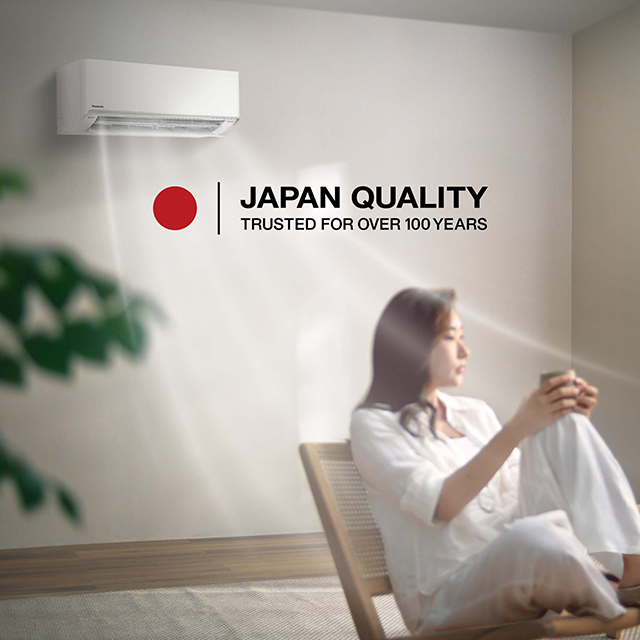Air conditioning
that complements
a building’s design

Like sunlight, greenery, and other natural elements,
good air quality has become an important aspect in
today’s increasingly sustainable building designs.
Text by Danielle Demetriou
Photography by Kunihisa Kobayashi

Art galleries. Residences. Clinics. Corporate spaces. The work of Kentaro Ishida, founder of Tokyo-based practice KIAS, has long spanned the architectural spectrum.
Underpinning his designs is a smooth interplay between his Japanese roots and a global outlook – a legacy of Ishida having been raised in several countries overseas before studying architecture in London and working in Switzerland with Herzog & de Meuron.
While his works are imbued with a genre-defying mesh of cultural reference points and spatial perspective, there is perhaps one quintessentially Japanese aesthetic that flows through it all – the idea of imperfection. One might find it in the organic aggregate texture of an exterior wall, the curved abstraction of layered roofs, or the subtle asymmetry of an interior space.
KIAS is perhaps best known for its cultural spaces. Ishida, who led the design of the Perez Art Museum Miami while at Herzog & de Meuron, is behind a string of noteworthy projects in Japan. They include N’s Yard, a clean-lined cube of stone and glass that sits wrapped in forests and serves as a private museum for Japanese artist Yoshitomo Nara; and Mitsukoshi Contemporary Gallery in Tokyo.
Air quality and ventilation have long been key considerations in his designs for such cultural spaces, with the architect often employing both cutting-edge technology rooted in sustainability as well as the natural resources of light and air.
Here, in an interview at his studio in the upscale Daikanyama neighborhood, Ishida talks about the value of fresh air, the shifting of lifestyles in a pandemic era, and the timeless appeal of imperfection.


Imperfection as a balancing element
Your work spans the spectrum from major museums and galleries to residences. How do you approach each project?
Every project is different and starts from scratch. We try to design without preconceptions, always taking into consideration the setting, the country, and the context. This is particularly the case for residential projects – everyone has different lifestyles and has different standards for quality of life and living spaces. It’s important for us to understand this as a starting point.
Are there any common threads that underpin your work?
One thing I am always interested in are materials and the different ways of using them. For example, in a housing project in Ota Ward, Tokyo, we crafted the first floor of the building to give it the look of a concrete box with exposed aggregate walls, using greenish serpentine stones. The texture is very subtle but creates a human, more natural look.
Everything is perfect in this world – especially Tokyo. Every surface is clean and even, an effect produced mostly using fake materials like printed wood. So we try to go in the opposite direction and make things a little imperfect. It’s like a traditional Japanese room, which is not a symmetrical space. There is normally a tokonoma – a space for the gods, for ancient spirits – raised about 50 mm from the ground and demarcated by a wooden column. These small gestures soften and balance the space. We often use techniques in line with this spirit – making surfaces a bit rough or more natural.

The need for architecture to evolve
How deeply influenced are you by traditional Japanese culture and aesthetics?
I lived in Bangkok until I was three, then attended elementary school in Los Angeles. I studied architecture in London for five years and then was based in Switzerland, working for Herzog & de Meuron for nine years before returning to Tokyo in 2012. So it’s very difficult to identify my exact inspirations. Perception of space is completely different here in Japan than in Europe. Japanese buildings are more fragile, very soft – mostly timber. European structures tend to be more rigid and use stone and bricks. But all these elements, for me, are on the same palette. Rather than feeling like I belong to just one culture, what I hope to do is combine all these elements – and reinterpret them, taking a step forward to create a new sense of boundary. It’s important for architecture to evolve, even if it’s a very small step. Every single detail – right down to doorknobs – should be questioned.
In the past few years, how has the pandemic impacted your work and the desires of your clients?
Clients are generally more focused on the quality of life in their homes. They are more careful in selecting furniture, for example, or want bigger baths. They are starting to stop and think about what brings richness to their lives at home. This is a big change. Many people are also leaving cities and heading to the regions to buy homes. There is a construction boom in Karuizawa [a mountain resort town an hour by train from Tokyo]. We’re working on two homes and a gallery there.

The role of air in design
How important a consideration is quality of air in your designs, and at what stage of the design is it incorporated?
It depends on the project. For office buildings, it’s particularly important as there are a greater number of people using them. In homes, it’s more about bringing in fresh air in a natural way. In general, the Japanese are more used to living with outdoor air. The idea of a window comes from Western countries. You make a hole in a wall, and it becomes a window. The Japanese, however, would traditionally install shoji screens and sliding doors so they could open up their homes whenever they felt like it. This means many Japanese homes are more in touch with nature – very cold in the winter and very warm in the summer as the outdoor air dictates. In modern Japanese homes, there is of course a widespread use of air conditioning, and the technology is evolving fast.
How do you tackle air quality challenges in your projects?
I think architects should be nature-conscious and find passive ways of using natural energy alongside technology. For example, in the spring and autumn, you can bring in fresh air to remove heat from the space. In Switzerland, there is even a regulation that if the roof is shallower than a certain degree, you have to “green” the roof to minimize heat loss. We are currently working on a project in Okinawa. In these southern, subtropical places, homes often have big eaves hanging over an engawa [exposed corridor] with no walls. They cast shadows that cool the corridor to a milder temperature and cut off reflective heat from the ground – but more importantly, this open design allows for natural ventilation that pushes hot air outside.


Conditioning a space
What kind of air quality innovations and technology do you often use in the spaces you design?
In galleries, or even residences with high ceilings, we often use displacement ventilation. It involves supplying cool air at the floor level at a very low velocity that is then pulled into the space that needs cooling through heat exchange. This means you only need to condition the space occupied by people – about two meters above the floor – and not the space above. It’s very low energy consumption. We incorporated this system in the main living space of the Four Leaves Villa in Karuizawa, as it has a high ceiling space, as well as in our museum projects.
What are the most important considerations when creating cultural spaces?
We often analyze the typology of different galleries – from classical to contemporary, like Fondation Beyeler in Switzerland and Tate Modern in London. Beyeler is a fantastic museum, laid out very intelligently with flexible wall systems. Air conditioning grilles have been installed all across the floor about 1.7 m apart each, so if you move the walls, you can still condition the whole space. Natural daylight enters all the museum’s galleries through the use of fins and blackout screens. There is also beautiful scenery. Galleries must be tied to their location. Think of how memorable Yayoi Kusama’s works on Naoshima are because of their natural locations. Another example is the Giacometti Gallery in the Louisiana Museum of Modern Art in Copenhagen, which has a brick floor and a big window that looks out to nature. Natural daylight, scenery, the view, the temperature – these are all important.

The frontiers of air ventilation
What are the key differences between Japanese and Western air ventilation systems?
European office spaces tend to like natural daylight and ventilation – which is very hard to provide in a Tokyo high-rise. In Japan, offices are often deep and illuminated with fluorescent lights – a very US style. But in Europe, you’re not allowed to design an office space without natural daylight for mental health reasons. I was working on a high-rise in Paris on a skinny site, so we drew two 12-meter-wide arced spaces, with an elevator shaft in the center. I think Japanese offices have the potential to improve natural daylight and air quality as well. Japanese are now changing their lifestyles due to the pandemic and desire natural conditions even in the working environments.
What are your thoughts on nanoeX technology?
We’ve actually used it in some of our projects. The quality and technology of Japanese air conditioning units have become amazing. An air-conditioning system is really an invention to provide a cost-efficient method to condition a space, and you cannot beat it. Some air-conditioning technology also provides ventilation – bringing outdoor air inside – and can also dehumidify and clean the space. This kind of technology helps buildings, particularly in Japan, which are often not equipped for natural ventilation or have small windows. They really help to provide the desired air quality. Japanese people are very sensitive to air quality, not only because of the pandemic but also due to pollen allergies, a legacy of planting cedars in the mountains since the Edo period. Moving forward, I think we will continue to see increased importance placed on air quality as more people move out of big cities to live in mountains or smaller cities with cleaner air. Good-quality air and natural ventilation are becoming more important for many Japanese.
Profile

Kentaro Ishida
Architect
Principal, Kentaro Ishida Architects Studio
Kentaro Ishida AA Dipl. studied architecture at the Architectural Association School of Architecture in London. He collaborated with Swiss architectural firm Herzog & de Meuron from 2004-2012. During his collaboration with H&dM he was leading a series of international projects as an Associate. He then established his Tokyo-based architectural studio, KIAS (Kentaro Ishida Architects Studio) in 2012. Alongside his architectural practice he is currently teaching architecture at Tokyo Institute of Technology as Associate Professor since 2016.
Related Products



















